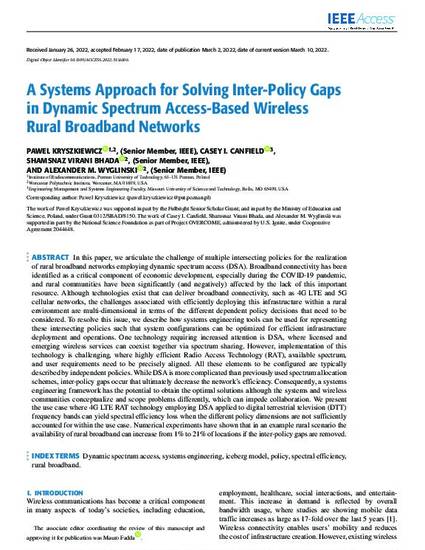
In this paper, we articulate the challenge of multiple intersecting policies for the realization of rural broadband networks employing dynamic spectrum access (DSA). Broadband connectivity has been identified as a critical component of economic development, especially during the COVID-19 pandemic, and rural communities have been significantly (and negatively) affected by the lack of this important resource. Although technologies exist that can deliver broadband connectivity, such as 4G LTE and 5G cellular networks, the challenges associated with efficiently deploying this infrastructure within a rural environment are multi-dimensional in terms of the different dependent policy decisions that need to be considered. To resolve this issue, we describe how systems engineering tools can be used for representing these intersecting policies such that system configurations can be optimized for efficient infrastructure deployment and operations. One technology requiring increased attention is DSA, where licensed and emerging wireless services can coexist together via spectrum sharing. However, implementation of this technology is challenging, where highly efficient Radio Access Technology (RAT), available spectrum, and user requirements need to be precisely aligned. All these elements to be configured are typically described by independent policies. While DSA is more complicated than previously used spectrum allocation schemes, inter-policy gaps occur that ultimately decrease the network's efficiency. Consequently, a systems engineering framework has the potential to obtain the optimal solutions although the systems and wireless communities conceptualize and scope problems differently, which can impede collaboration. We present the use case where 4G LTE RAT technology employing DSA applied to digital terrestrial television (DTT) frequency bands can yield spectral efficiency loss when the different policy dimensions are not sufficiently accounted for within the use case. Computer simulations have shown that in an example rural scenario the availability of rural broadband can increase from 1% to 21% of locations if the inter-policy gaps are removed.
- Dynamic Spectrum Access,
- Iceberg Model,
- Policy,
- Rural Broadband,
- Spectral Efficiency,
- Systems Engineering
Available at: http://works.bepress.com/casey-canfield/30/
